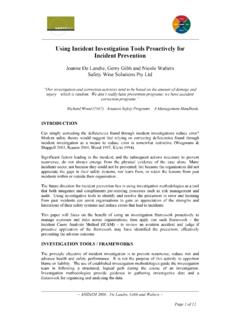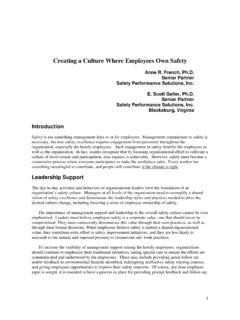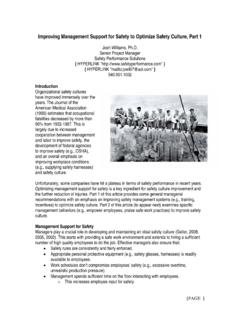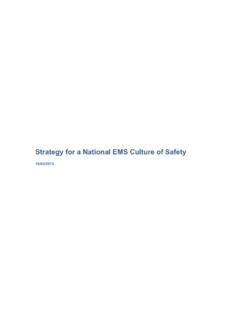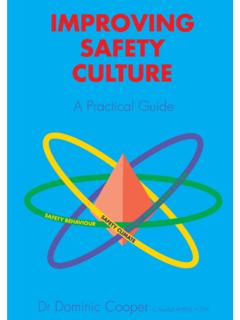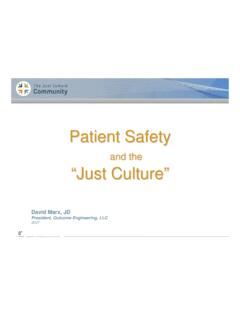Transcription of Safety Culture and its measurement in aviation - ASASI
1 Safety Culture and its measurement in aviation John A. Flannery Master of aviation Management Student University of Newcastle Australia November 2001. (This paper contains 6561 words not including references, appendices and title page). In this paper I describe the concept of Safety Culture ' and its measurement , with particular regard to aviation . The impetus for the paper stems from a proposed intervention into a segment of the aviation market and a desire to measure the effectiveness of the intervention. The paper commences with a discussion on the term safe(ty)' to place some boundaries on the term and to frame the proceeding discussion. Closely linked to the concept of Safety Culture ' is Safety Climate'. which is also discussed in some detail. Whilst the paper considers the divergence of views on the definitions of Safety Culture ' it also draws out significant similarities and ties different perspectives to a framework espoused by Cooper (1999).
2 As the paper demonstrates, measurement of Safety Culture ' can be a significant task however acceptable levels of measurement can be obtained by the administration and evaluation of surveys or questionnaires. The task The Civil aviation Safety Authority (CASA) is embarking on a project to articulate the benefits of Safety Management to a specific group within the aviation community of Australia. The group is Low Capacity Regular Public Transport (LCRPT) operators and was chosen after being identified as a group more at risk of having an accident than other groups. The project, which can be seen as an intervention, proposes to brief Page 1 of 29. senior management of LCRPT organizations on Systems Safety and the current CASA system Safety method' of surveillance.
3 The brief will be followed by a scheduled audit some months hence. The proposal The proposal is to measure the effect of the intervention. One mooted outcome of the intervention is an awareness of Systems Safety '. measurement prior to the intervention and post the audit appears to satisfy the when to measure' conundrum. The how and what to measure' needs scrutiny and is the focus of the literature review and subsequent position paper. As a starting point, measurement of Safety Culture '. appears to be reasonable. The following review focuses on defining Safety Culture '. and has broadly been sub divided into: Safety definition What to measure ( Culture , Culture sub components, and Safety Climate). How to measure (observation, audit and survey/questionnaire). Safety definition The definition of Safety needs to be explored in order to put a Safety Culture into some context within the aviation environment.
4 Safe appears to be one of those terms that everyone has a sense of but no one can quite define. Most definitions appear to fail to take into account future states by measuring what has happened; the supposition being that because you had no accidents or incidents you must be have been safe. This supposes that Safety is the absence of accident or incident. It would however, be ludicrous to advocate that Valuejet operations were safe before the accident into the everglades and then unsafe afterwards. The colloquial term often used to describe this phenomenon is an accident waiting to happen'. After discussing several dimensions of Safety ' the term will be framed for the purposes of this position paper. The Macquarie Dictionary defines safe as: safe safely, adverb safeness, noun /sayf/.
5 Adjective, safer, safest, noun, adverb Page 2 of 29. adjective 1. secure from liability to harm, injury, danger, or risk: a safe place. 2. free from hurt, injury, danger, or risk: to arrive safe and sound. 3. involving no risk of mishap, error, etc.: a safe estimate. 4. dependable or trustworthy: a safe guide. 5. cautious in avoiding danger: a safe player. 6. placed beyond the power of doing harm; in secure custody: a criminal safe in gaol. be on the safe side, Colloquial to take every precaution. It is easy to see that the dictionary definition is too simplistic for a complex environment such as aviation . It does however have significance as the way the public perceives Safety . That is, they expect to arrive safe and sound, free from risk. Hudson (2001, p.)
6 1) espouses a simple definition, Just make sure people don't get hurt'. This definition whilst simple has merit as it contains the element of a system (Just make sure) and the element of injury free (don't get hurt). Wood (1996, p. 28) notes that a workable aviation definition of Safety is based on the acceptability of risk, stating that, if a particular risk is acceptable then we consider that thing or operation acceptable. Conversely when we say something is unsafe, we are really saying that its risks are unacceptable . As Thomas (2001, p. 5) noted: A low accident rate, even over a period of years, is no guarantee that risks are being effectively controlled .This is particularly true in organizations where there is a low probability of accidents but where major hazards are present.
7 Here the historical record can be an unreliable or even deceptive indicator of Safety performance . Risk management therefore appears to be an inherent characteristic of being safe. Zohar's (1980) work is not in accord with this notion in that the validation of his climate survey was accident rates and his goal to define organisational characteristics that differentiate between high and low accident rate companies. The presence or absence of an unsafe act, then, does not appear to be a robust measure to describe an organisation as safe or unsafe. It does however appear appropriate (logical) to believe that the presence or absence of observed unsafe acts is a factor in the Safety measurement of an organisation (the weight of which is unknown). Page 3 of 29. System Safety Engineering and Management states that Safety may be defined as a quality of a system that allows the system to function under pre-determined conditions with an acceptable minimum of accidental loss.
8 In this way Safety should be thought of as a characteristic of a system. Interestingly Airservices Australia (2001, AA-Safe- 001, p. 1) defines Safety as Being in a situation where the risks of an aircraft accident or air Safety incident are reduced to a level as low as reasonably practicable . reinforcing the proposition that the working definition of Safety includes risk management. Safety can then be framed for the purposes of this paper as a characteristic of a system that does not permit unacceptable risks to be undertaken with the goal of injury free operations. What to Measure Culture . In order to measure something we must first determine what it is and then gain an understanding of it. In an attempt to understand Culture we should define it and then look at its sub components.
9 This in turn may give a clue to measurement of Safety Culture . Culture has been defined as the values, beliefs, rituals, symbols and behaviours that we share with others that help define us a group, especially in relation to other groups (Merrit and Helmreich, 1996, p. 1) and organisational Culture as a system of shared values, assumptions, belief and norms that join organisational members (Smircich 1988: Kilmann, Saxton & Serpa 1986 as cited in Bartol et al (1995, p. 101)). Hayward (1997, p. 1) quotes Hofstede (1980) where he indicates Culture is the collective programming of the mind which distinguishes the members of one group from another. UK Health and Safety Commission (1993, as cited in Cooper 1999, p. 2) define Safety Culture as the product of individual and group values, attitudes, competencies, and patterns of behaviour that determine the commitment to, and the style and efficiency of, an organizations Health and Safety programs.
10 Organisations with a positive Safety Culture are characterized by communications founded on mutual trust, by shared perceptions of the importance of Safety , and by confidence in the efficacy measures . Cooper (1999, p. 2) notes that the UK Health and Safety Page 4 of 29. Commission's definition is given prominence by researchers. Hudson (2001, p. 13). states that an organisation's Safety Culture is an evolutionary process from unsafe to safe and as such only after a certain point in development can an organization be said to take Safety sufficiently seriously to have a Safety Culture . Hudson (2001, p. 1). broadly defines Safety Culture as Who and what we are, what we find important, and how we go about doing things around here ; additionally Hudson (2001) links the organisation's Culture and therefore its Safety Culture to its development evolution.


